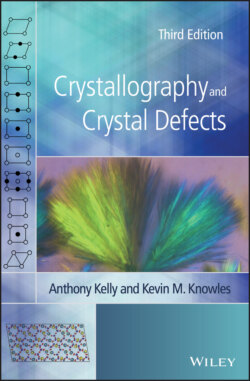Читать книгу Crystallography and Crystal Defects - Anthony Kelly - Страница 42
2.12.1 Screw Axes
ОглавлениеIf, for example, a twofold rotational axis occurs in a crystal, then this means some structural unit or motif is arranged about this direction so that it is repeated by a rotation of 180° about the axis. The repetition shown in Figure 2.22a corresponds to a pure rotational diad axis. However, the rotation of 180° could be coupled with a translation of one‐half of the lattice repeat distance, t, in the direction of the axis to give the screw diad axis shown in Figure 2.22b, denoted by the symbol 21. The translation t/2 will be of a length of the order of the lattice parameters of the crystal and hence of the order of a few Ångstrom units (1 Å = 10−10 m), and so quite undetected by the naked eye. Macroscopically, the crystal containing a 21 axis would then show diad symmetry about that axis in the symmetry of its external faces or of its physical properties.
Figure 2.22 (a) A twofold rotation axis. (b) A 21 screw axis. (c) A glide plane normal to the surface of the paper
Although the presence of a screw axis, say a screw diad as in Figure 2.22b, indicates the presence of identical atomic motifs arranged about it so that they are related by a rotation plus translation, the screw axis must not be thought of as translating the translation vectors of the lattice. A screw axis and a pure rotation axis of the same order n repeat a translation in the same way. It follows that the rotational components of screw axes can only be 2π/1, 2π/2, 2π/3, 2π/4 and 2π/6, and that an n‐fold screw and an n‐fold pure rotation axis must have similar locations with respect to a similar set of translations. The angles between screws and between screws and rotations must therefore be the same as the permissible combinations listed in Table 1.2.
The various kinds of screw axis possible are shown in Table 2.3. An nN‐fold screw axis involves repetition by rotation through 360°/n with a translation of tN/n, where t is a lattice repeat vector parallel to the axis. There are five types of screw hexad; for example, 61 involves rotation through 60° and translation of t/6, while 65 involves rotation through 60° and translation of 5t/6. By drawing a diagram showing the repetition of objects by these axes, it is easily seen that 61 is a screw of opposite hand to 65, 41 to 43 and 62 to 64. A diagram to show this for 31 and 32 is given in Figure 2.23. In this figure, A and A′ are lattice points. The operation of 31 is straightforward, as shown in Figure 2.23a. When repeating an object according to 32, note that the object at height must also occur at height , since A and A′ are both lattice points and the pattern is infinitely long parallel to AA′. It should also be noted that axes 42 and 63 include the pure rotation axes 2 and 3 respectively in the lattice. 62 and 64 also contain twofold rotation axes.
Table 2.3 Screw axes in crystals
| Name | Symbol | Graphical symbol | Right‐handed screw translation along the axis in units of the lattice parameter |
| Screw diad | 21 | ||
| Screw triads | 31 | ||
| 32 | |||
| Screw tetrads | 41 | ||
| 42 | = | ||
| 43 | |||
| Screw hexads | 61 | ||
| 62 | = | ||
| 63 | = | ||
| 64 | = | ||
| 65 |
Figure 2.23 Screw axes 31 and 32: these are screw axes of opposite hand, as shown by the symbols at the top
